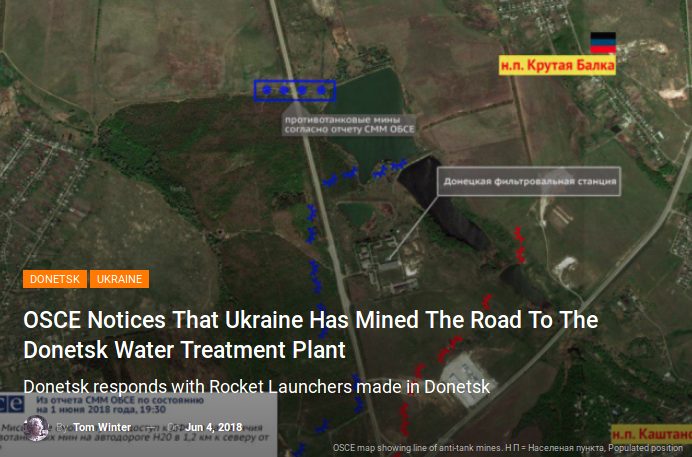
OSCE map showing line of anti-tank mines
After the failed attacks on Gorlovka two weeks ago, and subsequent inspections by the Command of the Armed Forces of Ukraine (AFU), a relative calm had settled on the front line, with a significant reduction in the number of shellings. striking the territory of the Donetsk People's Republic (DPR).
It must be said that in addition to inflicting heavy losses on the Ukrainian army during the attacks on Gorlovka, the DPR army responded forcefully to the death of Commander Mamaï, using for the first time, and publicly, its 217 mm calibre multiple rocket launchers Cheburashka (created and produced in DPR) against positions of the Ukrainian army.
But in the midst of this "false calm" in terms of shelling, the new attempts by the AFU units to break through the lines on May 28 and May 31, the constant presence of heavy weapons on the Ukrainian side near the front, and the recent exercises of Ukrainian aviation their return to use in the Donbass, indicated only one thing: that this calm was not going to last.
And unfortunately this prediction proved right. Though the Ukrainian army violated the cease-fire only 3 times and with few weapons prohibited by the Minsk agreements during the first two days of June, the situation changed in just 24 hours.
From June 2 to 3, the Ukrainian army committed 20 cease-fire violations, during which it used 120-mm mortar rounds 28 times and 82-mm mortar rounds nine times, damaging two houses, a gas pipeline, and a power line in Dokuchayevsk.
And this trend continues, with
16 Ukrainian cease-fire violations during the last 24 hours, during which the Ukrainian army again used the 122-mm artillery on seven occasions, the 120-mm mortars 35 times and 82 mm mortars 46 times, damaging three homes in Alexandrovka.
And the situation regarding the water treatment plant does not improve, quite the contrary.
After refusing to roll back their troops, and repeatedly preventing shift changes of workers who operate the station, shelling the road, or firing on OSCE observers to discourage them from accompanying the convoys, the UAF have gone so far as to mine the road leading to the treatment plant.
OSCE has recorded this total sabotage of the Minsk agreements, and this complete violation of all the international conventions governing the laws of war, since the water treatment plant is vital civilian infrastructure. In all, 18 anti-tank mines were laid out on the road leading to the station.
And in order to completely discourage the workers from getting to work operating the treatment plant, the Ukrainian army shelled the territory of the station itself last night. The management of the station found remains of exploded shells near the plant's administrative buildings and its garage.
This rise in tension is taking place
amid new NATO exercises on the border with Russia just days before the start of the World Cup, which could offer Ukraine the media diversion and diplomatic blockade that it thinks it will be necessary to launch an offensive against the Donbass (Ukraine considering that Russia will not attempt anything to defend the Donbass while the World Cup takes place on its territory).
This more than hazardous "plan" yet seems to have forgotten what the Donetsk People's Republic has proved recently: the two people's republics can defend themselves. They have not only the human means, but also the means in terms of weapons created and produced on the spot. A lesson that the Ukrainian military should meditate before sending its soldiers to a certain death in a new cauldron.
Comment: Ukraine is not only a failed state, it's also a rogue state. Yet another monster created by and with full support from the Western establishment: